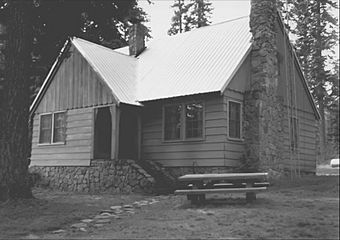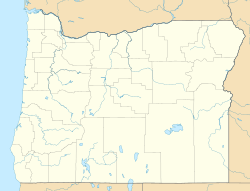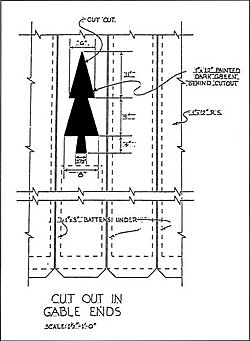Lake of the Woods Ranger Station facts for kids
Quick facts for kids |
|
|
Lake of the Woods Ranger Station
|
|

Lake of the Woods Ranger's Residence, 1983
|
|
| Location | Fremont-Winema National Forests |
|---|---|
| Nearest city | Klamath Falls, Oregon, USA |
| Built | 1937–1939 |
| Architect | United States Forest Service, Pacific Northwest Regional Architecture Group |
| Architectural style | Cascadian rustic |
| NRHP reference No. | 86000845 |
| Added to NRHP | 1986 |
The Lake of the Woods Ranger Station is a special place with eight buildings. It sits high above Lake of the Woods in southern Oregon. This area is part of the Fremont-Winema National Forests.
All these buildings were made by the Civilian Conservation Corps (CCC) between 1937 and 1939. Today, the station is a busy work center for the United States Forest Service. The old office building is now a visitor center for people to enjoy. This historic ranger station is so important that it is on the National Register of Historic Places.
Contents
History of the Ranger Station
In the early 1900s, forest roads were not very good. To help manage the National Forests, the Forest Service built ranger stations. These stations were placed in key spots. They gave homes to full-time workers. They also helped fire patrols and work crews in faraway forest areas.
After World War II, the Forest Service built many more roads. This made it easier for workers to reach most forest areas quickly. Because of this, many isolated ranger stations closed. Some became summer guard stations. The Lake of the Woods Ranger Station was built during this early time. It is still used by Forest Service crews today.
Early Days at Lake of the Woods
In 1898, the Cascade Forest Reserve was created in southern Oregon. The forest around Lake of the Woods became part of this reserve. The forest was managed as part of the Cascade reserve until 1908. Then, the area moved to the Crater National Forest.
The Forest Service gave out the first permit for a private cabin at Lake of the Woods in 1916. In 1920, the Forest Service built a public campground at the lake. This spot became very popular. In its first year, 1,850 summer visitors used the campground.
In 1923, the road to Lake of the Woods was made better. That same year, the Forest Service built a second campground. This was to handle the growing number of people vacationing at the lake. In 1926, the Forest Service allowed the Lake of the Woods Recreation Company to build a resort there.
During this time, the only Forest Service building at the lake was a small log cabin. A fur trapper likely built it around 1900. In 1929, the Forest Service replaced this cabin. They built a much larger ranger office at the north end of the lake.
Building with the CCC
In 1932, the Lake of the Woods Ranger Station moved to the Rogue River National Forest. This included the lakeside campgrounds and the surrounding forest. In the mid-1930s, the Civilian Conservation Corps (CCC) built many new buildings at the ranger station.
The CCC was a program during the Great Depression. It gave jobs to young men. They built roads, parks, and buildings. Almost all the new structures at Lake of the Woods were built in the Cascadian rustic style. This style uses natural materials to blend with the outdoors.
Changes Over Time
In 1961, the Forest Service moved Lake of the Woods and its forest again. This time, it went to the new Winema National Forest. In 2002, the Winema National Forest joined with the Fremont National Forest. They became the Fremont-Winema National Forests.
The Klamath Ranger District of the Winema National Forest still uses the ranger station. It is a work center for their crews. The old office building is now a visitor center. It is open during the summer months.
All eight of the ranger station buildings are very important historically. They are still in great shape. The Lake of the Woods Ranger Station is special because it is an early Forest Service station. Because of its unique history, it was added to the National Register of Historic Places on April 8, 1986. The historic area covers about 9.6 acres (3.9 hectares).
Buildings at the Station
The Lake of the Woods Ranger Station has eight historic buildings. It is a great example of a classic Forest Service ranger station. The Forest Service's Pacific Northwest Regional Architecture Group designed these buildings. The Civilian Conservation Corps (CCC) built all of them between 1937 and 1939.
They built a ranger station office, two homes for rangers, and a house for the crew. They also built a garage, a gas and oil shed, a storage shed, and a barn. Most buildings are in the Cascadian rustic style. They used weatherboard, wood shingles, local stone, and concrete. The barn is different; it is made of peeled logs. Many of the gables (the triangular parts of a roof) have open pine tree cutouts. This was a common design for Forest Service buildings in the 1930s.
- The Ranger Station Office is a one-and-a-half-story building. It has a wood frame on a concrete foundation. The outside of the foundation has stone. It has a high gabled roof with a cross gable in the middle. A stone chimney sits where the gables meet. The main door is set back under a gable. Five stone steps lead to a flagstone porch. Four large wooden posts with curved supports hold up the porch. The back door is also under a gable. The back porch has similar wooden supports. The outside walls are covered with horizontal boards up to the roof's edge. The gable ends have vertical boards. There are eight-over-eight double-hung sash windows on all sides. Three open pine tree cutouts are above the front porch. The middle tree is larger. A "Visitor Center" sign is below the trees. The roof is made of textured metal. Inside, the walls have knotty-pine wood panels. There is a stone fireplace with a wooden mantel. The floors are wood, and the ceiling has exposed wooden beams.
- The Ranger Residence is a one-and-a-half-story T-shaped building. It sits on a concrete foundation with visible stone. It has a wood frame with horizontal boards on the outside walls. Vertical boards are on the gable ends. The building has a high gable roof. A large gable is on the east end. A porch gable sticks out on the south side. The original wood shingle roof was replaced with textured metal. The front porch has two heavy square wooden posts with curved supports. Stone steps lead to an open porch with a flagstone floor. The back door is on the north side. The covered back porch has one heavy square wooden post with a curved support. A stone chimney is on the north gable end. The outside has simple six-over-six double-hung sash windows. Inside, the walls have knotty-pine wood panels. A stone fireplace is a main feature. The ceiling has exposed wooden beams.
- The Assistant Ranger Residence is a one-and-a-half-story L-shaped building. It has a concrete foundation with visible stone. It is a wood-frame building. Horizontal boards cover the outside walls. Vertical boards are on the gable ends. The building has a high gable roof. An offset gable on the north side creates the L-shape. The roof is textured metal. The open front porch is covered by the projecting gable. Two square wooden posts with curved supports hold it up. The porch has a flagstone floor, reached by five stone steps. There is a chimney on the west side of the building. The outside has six-over-six double-hung sash windows.
- The Residential Garage is next to the ranger residence. It is a rectangular, wood-frame building. It has a concrete foundation with visible stone. The garage has a high gable roof. The outside walls have horizontal boards up to the roof's edge. Vertical boards are on the gable ends. There are two hinged doors on the north gable end. A single large pine tree cutout is in the center above the doors. The original wood shingle roof was replaced with textured metal.
- The ranger station Crew Bunkhouse is also an equipment warehouse. It is a one-and-a-half-story rectangular building. It has a wood frame on a concrete foundation with visible stone. It has horizontal boards on the outside walls. Vertical boards with battens are on the gable ends. The building has a high gable roof with a center porch gable on the east side. The open front porch is under the center gable. Heavy square wooden posts with curved supports hold it up. The front steps and porch are concrete. A sliding wooden door next to the main entrance leads to the warehouse. The outside has six-over-six double-hung sash windows. A single large pine tree cutout is above the porch. There are also pine tree cutouts on the north and south gable ends. The building has a textured metal roof.
- The ranger station's Gas and Lube Building is a wood-frame building. It has a concrete foundation with visible stone. The outside walls have horizontal boards up to the roof's edge. Vertical boards are on the gable ends. It has a high gable roof. The middle part of the roof's northern side extends out. It forms a shed-porch that covers the gas pump. The main entrance to the shed is also under this porch. Two pairs of square wooden posts with curved supports hold up the shed extension. There is a loading dock on the west gable end. A sliding door leads to the loading dock. The building has a textured metal roof.
- There is a small Storage Shed near the gas and lube building. It is a wood-frame building with a gable roof. It sits on a simple concrete foundation. The outside walls have horizontal boards up to the roof's edge. Vertical boards are on the gable ends. The only door is on the north side. The shed has simple six-pane single-sash windows. The shed has a textured metal roof.
- The Barn is the only historic building not in the Cascadian Rustic style. It is a one-and-a-half-story rectangular building made of peeled logs. It sits on concrete piers. The barn has a high bell-cast gambrel roof covered with wood shingles. The log walls fit together at notched corners. The logs stick out about 1 foot (0.3 meters) beyond the corners. The windows on the ground floor have four or six panes. The main door is off-center on the west end. It is a wooden door with a six-pane window. There is also a single sliding door on the east end for animals. On the second floor, there is a two-leaf hay door in the center of the west gable. This door leads to the hayloft.
Location and Surroundings
The Lake of the Woods Ranger Station is in western Klamath County, Oregon. It is surrounded by the Winema National Forest. The station is about 4,997 feet (1,523 meters) above sea level.
The area around the ranger station has a thick forest. It has many different types of conifer trees. Douglas-fir and white fir are common. You can also find ponderosa pine, lodgepole pine, and aspen trees. This area gets about 30 to 44 inches (760 to 1,100 millimeters) of rain and snow each year.
The ranger station is near the top of the Cascade Mountains. It is on the north shore of Lake of the Woods. It is about 33 miles (53 kilometers) west of Klamath Falls. It is also about 43 miles (69 kilometers) east of Medford, Oregon. The ranger station is just off Oregon Route 140. All the historic buildings are on a narrow strip of land. This land is between the highway and the lake. The old ranger station office is now a Forest Service visitor center. It is open during the summer months.









